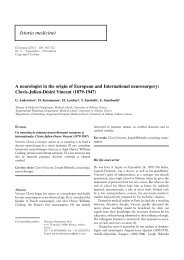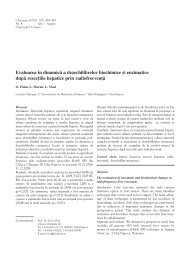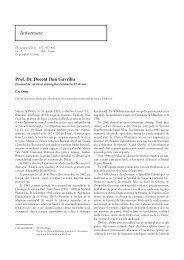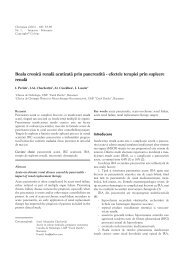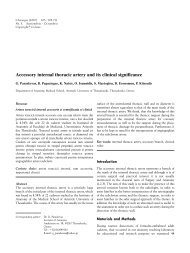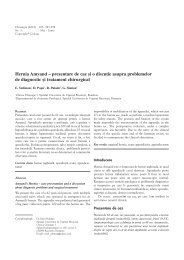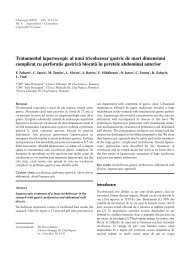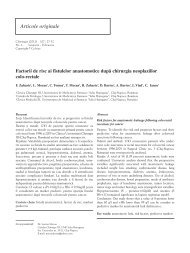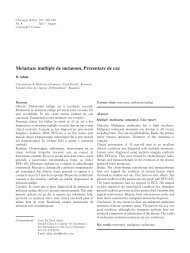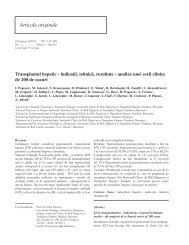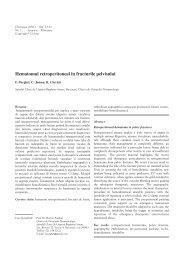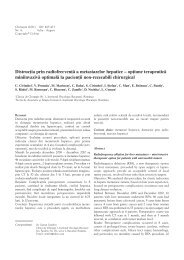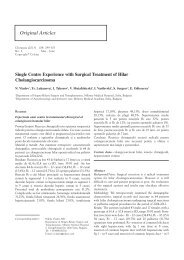Celsius - Chirurgia
Celsius - Chirurgia
Celsius - Chirurgia
You also want an ePaper? Increase the reach of your titles
YUMPU automatically turns print PDFs into web optimized ePapers that Google loves.
<strong>Chirurgia</strong> (2013) 108: 312-318<br />
No. 3,<br />
May - June<br />
Copyright© <strong>Celsius</strong><br />
Mortality and Need of Surgical Treatment in Acute Upper Gastrointestinal<br />
Bleeding: A One Year Study in a Tertiary Center with a 24 Hours / Day-7<br />
Days / Week Endoscopy Call. Has Anything Changed?<br />
A.M. Boåianu 1,2 , D. Matei 1 , M. Tanåãu 1 , M. Acalovschi 1<br />
1<br />
"Professor Dr. Octavian Fodor” Regional Institute of Gastroenterology and Hepatology, "Iuliu Haåieganu” University of Medicine<br />
and Pharmacy, Cluj Napoca, Romania<br />
2<br />
University of Medicine and Pharmacy Târgu Mureş, Internal Medicine Departament, Târgu Mureş, Romania<br />
Corresponding author:<br />
Ana-Maria Boåianu, MD<br />
No.66/1 Gheorghe Marinescu Street<br />
Târgu Mureş, Mureş County, Romania<br />
E-mail: anamariabotianu@yahoo.com<br />
Rezumat<br />
Mortalitatea æi necesarul de tratament chirurgical<br />
în hemoragia digestivã superioarã acutã: un studiu<br />
pe o perioadã de un an într-un centru teråiar cu<br />
gardã permanentã de endoscopie. S-a schimbat ceva?"<br />
Introducere: Deşi în trecut o frecventã urgenåã chirurgicalã,<br />
hemoragia digestivã superioarã constituie la ora actualã cea<br />
mai frecventã urgenåã gastroenterologicã.<br />
Scop: Evaluarea situaåiei actuale privind mortalitatea şi<br />
necesarul de tratament chirurgical în hemoragia digestivã<br />
superioarã.<br />
Material şi metodã: Studiu clinic retrospectiv nerandomizat<br />
desfãşurat la Institutul Regional de Gastroenterologie şi<br />
Hepatologie “Profesor Dr. Octavian Fodor” din Cluj Napoca.<br />
757 de pacienåi cu hemoragie digestivã superioarã au fost<br />
examinaåi endoscopic în primele 24 de ore de la prezentare.<br />
Datele au fost colectate din foile de observaåie şi programul<br />
Hospital Manager. Pentru analiza statisticã, am efectuat<br />
testele: chi pãtrat, Spearman, Kruskall-Wallis, Mann-Whitney,<br />
AUROC (area under receiver operating curve).<br />
Rezultate: A predominat etiologia non-varicealã, etiologia<br />
principalã fiind cea ulceroasã. Mortalitatea intraspitaliceascã<br />
globalã a fost de 10.43%, rata de resângerare de 12.02%, tratamentul<br />
chirurgical fiind efectuat în 7.66% din cazuri. 3.68%<br />
din cazurile de hemoragie nonvaricealã au necesitat hemostazã<br />
chirurgicalã de urgenåã. Necesarul de tratament chirurgical s-a<br />
corelat cu scorul Rockall complet (p=0.0425). Pentru ulcerul<br />
peptic, necesarul chirurgical nu a fost influenåat de momentul<br />
endoscopiei sau tipul de tratament efectuat (p=0.1452).<br />
Prezentarea în cursul weekendului (p=0.996) sau a nopåii<br />
(p=0.5414) nu s-a corelat cu un necesar mai mare de intervenåie<br />
chirurgicalã.<br />
Concluzii: În ultimul deceniu, necesarul de tratament<br />
chirurgical de urgenåã în hemoragia superioarã digestivã s-a<br />
redus cu 50% dar mortalitatea a rãmas constantã.<br />
Cuvinte cheie: hemoragie digestivã superioarã, hemostazã<br />
endoscopicã, tratament chirurgical, mortalitate<br />
Abstract<br />
Background: Acute upper gastrointestinal bleeding, previously<br />
often a surgical problem, is now the most common gastroenterological<br />
emergency.<br />
Aim: To evaluate the current situation in terms of mortality<br />
and need of surgery.<br />
Subjects and methods: Retrospective non-randomised clinical<br />
study performed between 1st January-31st December 2011, at<br />
"Professor Dr. Octavian Fodor” Regional Institute of Gastroenterology<br />
and Hepatology in Cluj Napoca. 757 patients with<br />
upper gastrointestinal bleeding were endoscopically examined<br />
within 24 hours from presentation in the emergency unit. Data<br />
were collected from admission charts and Hospital Manager
313<br />
programme. Statistical analysis was performed with GraphPad<br />
2004, using the following tests: chi square, Spearman, Kruskall<br />
–Wallis, Mann-Whitney, area under receiver operating curve.<br />
Results: Non-variceal etiology was predominant, the main<br />
cause was bleeding being peptic ulcer. In hospital global<br />
mortality was of 10.43%, global rebleeding rate was 12.02%,<br />
surgery was performed in 7.66% of patients. Urgent haemostatic<br />
surgery was needed in 3.68% of patients with nonvariceal<br />
bleeding. The need for surgery correlated with the postendoscopic<br />
Rockall score (p=0.0425). In peptic ulcer, the need for<br />
surgery was not influenced by time to endoscopy or type of<br />
treatment (p=0.1452). Weekend (p=0.996) or night<br />
(p=0.5414) admission were not correlated with a higher need<br />
for surgery.<br />
Conclusions: Over the last decade, the need for urgent<br />
surgery in upper gastrointestinal bleeding has decreased by<br />
half, but mortality has remained unchanged.<br />
Key words: upper digestive bleeding, endoscopic hemostasis,<br />
surgery, mortality<br />
Introduction<br />
Formerly a mainly surgical problem, acute upper gastrointestinal<br />
bleeding has become the most common gastroenterological lifethreatening<br />
emergency. Management strategies have changed<br />
dramatically over the last 20 years due to the introduction of<br />
acid suppressive therapy as well as endoscopic haemostasis, with<br />
a decrease in surgical need, but relatively unchanged mortality<br />
rates of 6-13% in most studies. Mortality can reach higher<br />
values in variceal bleeding (1-4). The majority of deaths do not<br />
result from failure of haemostasis, either medical or surgical, but<br />
mainly from comorbidities, poorly tolerated blood loss and<br />
resultant complications (3,4). Management strategies are clearly<br />
defined by national and international guidelines (5-12), but<br />
treatment varies according to local experience and medical<br />
resources, especially the availability of permanent endoscopic<br />
diagnosis and haemostasis. Currently, international guidelines<br />
(5-11) support the use of upper endoscopy within 24 hours for<br />
patients presenting with upper gastrointestinal bleeding. The<br />
guideline of The Romanian Society of Gastroenterology and<br />
Hepatology and The Romanian Society of Endoscopy reduces<br />
timing recommendations to 16 hours from presentation (12). In<br />
high risk patients presenting with haematemesis/haematochezia<br />
or hemodynamic instability, endoscopy is recommended as soon<br />
as possible. Despite a rich international literature-on risk factors<br />
and outcome in acute upper gastrointestinal bleeding, in our<br />
country there are relatively few recent data on outcome,<br />
including the need for surgery.<br />
The aim of the present study was to obtain actual data<br />
on acute upper gastrointestinal bleeding regarding etiology<br />
and outcome, as well as to study the factors correlated with<br />
mortality, rebleeding and need of surgical treatment in a<br />
tertiary specialized center, with a permanent endoscopy call<br />
(24 hours/day, 7 days/week).<br />
Materials and Methods<br />
This is a retrospective non-randomised clinical study<br />
performed on the patients evaluated between 1 st of January -<br />
31 st of December 2011. The study took place at the 3 rd Medical<br />
Clinic, "Professor Octavian Fodor” Regional Institute of<br />
Gastro-enterology and Hepatology in Cluj Napoca. Patients<br />
were considered for the study if they had evidence of overt<br />
gastro-intestinal bleeding on admission or a recent history of<br />
hematemesis/ground vomiting, melena, haematochezia or a<br />
combination of any of the above. All patients were endoscopically<br />
examined within 24 hours from presentation to the<br />
emergency unit. In hospital bleedings were also included in<br />
our study. Data collected from admission charts and Hospital<br />
Manager programme included: age and sex, etiology,<br />
previously validated prognostic scores (pre- and postendoscopic<br />
Rockall score, Glasgow-Blatchford score), endoscopic<br />
data (Forrest classification for non-variceal bleeding, the<br />
presence of ongoing/stopped bleeding), use of antiplatelet/anticoagulant<br />
medication, time to endoscopy from admission to<br />
the emergency unit, time of emergency unit presentation<br />
(night/day, weekend/weekday), treatment. Outcome was<br />
analysed in terms of in hospital death and need of surgical<br />
therapy. Statistical analysis was performed with GraphPad<br />
2004, using the following tests: chi square, Spearman, Mann-<br />
Whitney, area under receiver operating curve.<br />
Results<br />
During the mentioned period, 757 endoscopies were<br />
performed for the diagnosis of acute upper gastrointestinal<br />
bleeding. Patient characteristics are given in Table 1 and 2.<br />
Non-variceal etiology was dominant; the main cause of<br />
upper gastrointestinal bleeding was gastric and duodenal ulcer.<br />
The second most frequent cause was variceal etiology, mainly<br />
esophageal and rarely gastric location. The following cause was<br />
neoplasia of the upper gastrointestinal tract, especially<br />
ulcerated lesions with oozing or adherent clot, and gastric<br />
Table 1.<br />
Clinical characteristics of the patients with upper<br />
digestive bleeding<br />
Age : 62.11±13.37 years<br />
Gender: 413 (54.42%) males: 345 (45.57%) females<br />
High risk patients according to prognostic scores<br />
Postendoscopic Rockall score: 461 patients.<br />
Glasgow-Blatchford score: 432 patients.<br />
Medication and alcohol use<br />
Anticoagulation: n=53 (7%)<br />
NSAID : n=130 (17.17%)<br />
Aspirin: n=65 (8.58%)<br />
Clopidogrel : n=7 (0.92%)<br />
Alcohol: n=288 (38.04%)<br />
Mode of presentation<br />
Hematemesis: n=380 (50.19%)<br />
Melena: n=750 (99.07%)<br />
Hematochesia: n=35 (4.62%)
314<br />
Table 2.<br />
Endoscopic characteristics of the 757 patients<br />
Etiology<br />
Variceal bleeding-n=184 (24.30%)<br />
Portal congestive gastropathy-n=10 (1.32%)<br />
Peptic ulcer- n=308 (40.68%)<br />
Gastric ulcer- n=143 (18.89%)<br />
Duodenal ulcer- n=134 (17.70%)<br />
Recurrent anastomosis ulcer-n=28 (3.69%)<br />
D2 duodenal ulcer-n=3 (0.39%)<br />
Angiodysplasia-n=14(1.84%)<br />
Erosive bulbitis-n=7 (0.92%)<br />
Erosive gastritis-n=55 (7.26%)<br />
Oesophagitis- n=20 (2.64%)<br />
Esophageal ulcer- n=16 (2.11%)<br />
Dieulafoy lesion- n=12 (1.58%)<br />
Cameron lesion- n=4 (0.52%)<br />
Mallory-Weiss syndrome-n=38 (5.01%)<br />
Source of bleeding not identified- n=3 (0.39%)<br />
Aorto-duodenal fistula- n=3 (0.39%)<br />
Posttherapeutic- n=8 (1.05%)<br />
Neoplasia: n=70p (9.24%).<br />
Esophageal- n=6 (0.79%)<br />
Eso-cardio-tuberositary location- n=9 (1.18%)<br />
Stomach- n=50 (6.60%)<br />
Vaterian ampuloma (exulcerated)-n=3 (0.39%)<br />
Extrinsec tumoral invasion-n=2 (0.26%)<br />
Other: 5 (0.66%)<br />
Activity during the first endoscopy<br />
Stopped bleeding: n=554p. (73.18%)<br />
Ongoing bleeding: n=203p.(26.81%)<br />
Stigmata of recent haemorrhage<br />
Nonvariceal (n= 563p.). Forrest classification<br />
IA: n=28 (4.97%).<br />
B: n= 109 (19.36%)p.<br />
IIA: n= 88 (15.63%)<br />
B: n= 97 (17.22%)<br />
C: n= 33 (5.86%)<br />
III: n=208 (36.94%)<br />
Variceal bleeding (n=194p.)<br />
Active bleeding: n =66 (34.02%)<br />
Spurting:n=57 (29.38%)<br />
Oozing:n=9 (4.63%)<br />
Stopped bleeding: n=128 (65.97%)<br />
Collapsed varices: n=9 (4.63%)<br />
Adherent clot: n=21 (10.82%)<br />
Red spots: n=72 (37.11%)<br />
Hematocystic dilatations: n=16 (8.24%)<br />
Congestive gastropathy: n=10 (5.15%)<br />
cancer, eso-cardiotuberositary and esophageal location. Other<br />
frequent causes included erosive disease (gastritis or duodenitis)<br />
and Mallory-Weiss tear. We noticed a very small number of<br />
cases in which the source of the bleeding was not localised,<br />
stress ulcer, as well as postprocedural bleeding. Bleeding<br />
complications of procedures such as gastric polypectomy,<br />
endoscopic sphincterotomy with stone extraction or endoscopic<br />
biliary prosthesis for cholangiocarcinoma, were present<br />
mainly in patients with coagulation impairment (elevated<br />
I.N.R., haemophilia).<br />
A significant proportion of the patients included in our<br />
study were high risk patients according either to a Glasgow-<br />
Blatchford score >=12 points (57.06% of patients) or a<br />
postendoscopic Rockall score >=6 points (60.89% of<br />
patients). Only 4 patients had a Glasgow-Blatchford score of<br />
0 with a possible indication of outpatient management.<br />
Despite high risk scores in over 50% of the patients, most<br />
bleedings were not active at the time of endoscopy but high<br />
risk bleeding stigmata were dominant, especially visible<br />
vessels without active bleeding and lesions with adherent<br />
clot.<br />
From the timing point of view, we found that most<br />
patients presented during daytime (n=523 patients), most<br />
frequently between 9-10 a.m. and that a significant number<br />
of cases presented during the weekend (n=225 patients). All<br />
endoscopies were performed within 24 hours from presentation,<br />
ranging from 1 minute to 1437 minutes, the median time<br />
to endoscopy being 306.6 minutes (5 hours and 6 minutes).<br />
The treatment strategy was adapted to the etiology and<br />
type of endoscopic lesion. The most used endoscopic<br />
haemostasis method was injection therapy, usually 1:10.000<br />
adrenalin injection (n=250 patients, 33.02%). Other techniques<br />
included hemoclip placement (n=55 patients, 7.26%),<br />
argon plasma coagulation (n=25 patients, 3.3%),variceal band<br />
ligation (n=164 patients, 21.66%) and combined therapy,<br />
mainly injection therapy associated with hemoclip placement<br />
(n=49 patients, 6.47%). Two hundred and seventy eight<br />
(36.72%) patients did not require endoscopic or surgical intervention.<br />
Surgery was performed in 58 patients, representing<br />
7.66%. Three patients refused surgical intervention with a<br />
good short-term outcome, the indication for surgical treatment<br />
was decided for in case of malignancy and not failure of<br />
medical haemostasis.<br />
In hospital global mortality was 10.43% and global<br />
rebleeding rate was 12.02% (91 out of 757 patients).<br />
Mortality<br />
Mortality rate was correlated with all prognostic scores (Mann-<br />
Whitney test, p
315<br />
Table 3.<br />
Mortality rates according to etiology and endoscopic<br />
lesions<br />
Etiology<br />
Angiodysplasia: n=2/14p. (14.28%)<br />
Dieulafoy lesion: n=0/12p. (0%)<br />
Erosive disease: n=4/62p (6.45%)<br />
Neoplasia: n=9/70p. (12.85%)<br />
Mallory Weiss tear: n=1/38p. (2.63%)<br />
Peptic ulcer: n=29/308p. (9.41%)<br />
Variceal bleeding: n=26/194p. (13.4%)<br />
Spurting: n=3/57p. (5.26%)<br />
Oozing: n=4/9p. (44.4%)<br />
Adherent clot: n=4/21p. (19.04%)<br />
Hematocystic dilatations: n=1/16p. (6.25%)<br />
Red spots: n=10/72p. (13.88%)<br />
Collapsed varices: n=4/9p. (44.4%)<br />
Total: n=79/757p. (10.43%)<br />
Active bleeding: n=19/203p. (9.35%)<br />
Stopped bleeding: n=60/554p. (10.80%)<br />
Figure 1.<br />
Area under receiver operator curve, for time to<br />
endoscopy in high risk patients according to Glasgow-<br />
Blatchford score (>12 points), variceal and nonvariceal<br />
etiology<br />
no statistical difference between mortality rates if we compared<br />
night versus day admission (p=0.6250) or weekday versus<br />
weekend admission (p=0.1152). Time to endoscopy within 24<br />
hours from presentation did not correlate with mortality, on a<br />
global analysis. When we analysed the nonvariceal cases based<br />
on Forrest classification, we did not find a correlation with<br />
time for type IA (p=0.3728) or IIB (p=0.3870) lesions.<br />
Within 24 hours of presentation to endoscopy, in patients with<br />
gastric or duodenal ulcer, mortality was not influenced by time<br />
when analysed according to the type of endoscopic treatment.<br />
A time analysis for low risk patients was not possible due to<br />
the very low mortality rates. For high risk patients according to<br />
complete Rockall score, there was no correlation between time<br />
to endoscopy and mortality rates (p=0.8903) within 24 hours<br />
from presentation. For the Glasgow-Blatchford score, which is<br />
a non-endoscopic one, we found statistically significant<br />
mortality rates for a score higher or equal to 12 points. The<br />
global analysis for all etiologies of gastrointestinal bleeding<br />
revealed an AUROC value of 0.6352, with a cut-off value of<br />
260 minutes, at a 100% sensitivity and a 95 % confidence<br />
interval of 0.5689 - 0.7015 (Fig. 1). The analysis only for<br />
variceal bleedings showed a time cut-off value at 99.03<br />
minutes, with an AUROC value of 0.5595, a sensitivity of<br />
100% and a 95% confidence interval of 0.4572 -0.6618<br />
(Fig. 2). For nonvariceal bleedings with a Glasgow-Blatchford<br />
score higher or equal to 12 points, the time cut-off value was<br />
Figure 2.<br />
below 1,435 minutes, close to the upper limit of the time<br />
interval.<br />
Need for surgery<br />
Area under receiver operator curve, for time to<br />
endoscopy in high risk patients according to Glasgow-<br />
Blatchford score (>12 points), variceal etiology<br />
Surgical treatment was indicated in 61 patients and<br />
performed in 58 (7.66%). For nonvariceal bleedings and the<br />
Table 4.<br />
Relative risk<br />
of rebleeding<br />
according to<br />
type of treatment<br />
Type of treatment Relative risk Odds P value, chi<br />
ratio square test<br />
Injection therapy 1.164 1.231 0.3172<br />
Combined endoscopic therapy 1.329 1.361 0.4108<br />
Plasma argon coagulation 0.4949 0.4893 0.4807<br />
Acid suppressive therapy 0.6414 0.5665 0.0281<br />
Injection versus combined therapy 0.9813 0.9044 0.8019<br />
Injection versus plasma argon coagulation 1.040 2.516 0.3606<br />
Combined versus argon plasma coagulation 1.178 2.782 0.3299
316<br />
indication of urgent haemostasis due to impossibility of<br />
endoscopic treatment or rebleeding, surgery was required in 21<br />
patients, i.e. surgery was needed in 3.68% of these patients.<br />
Surgery was indicated by several situations, not necessarily<br />
failure of endoscopic haemostasis: rebleeding lesions in 9 cases;<br />
massive active haemorrhage with impossibility to attempt<br />
endoscopic haemostasis in 15 cases (main causes: massive<br />
bleedings with poor visualization of the lesion and luminal<br />
stenosis with impossibility of reaching the lesions endoscopically).<br />
Failure of endoscopic haemostasis did not necessarily<br />
mean surgical treatment, which was recommended mainly in<br />
case of upper gastrointestinal malignancy. In patients in whom<br />
endoscopic haemostasis was achieved, the surgical indication<br />
was a diagnosis of malignancy of the upper gastrointestinal<br />
tract (18 cases) or complications such as luminal stenosis<br />
(duodenal ulcer 2 cases, antral neoplasm 4 cases) or penetration<br />
and perforation (gastric ulcer 2 cases).<br />
Surgery was performed in 27 cases of peptic ulcer (14<br />
duodenal and 13 gastric ulcer), 1 case of Dieulafoy lesion,<br />
27 cases of upper gastrointestinal malignancy and 3 cases of<br />
aortoduodenal fistula. Surgery was not performed in any of<br />
the patients with variceal bleeding.<br />
The need for surgical treatment was correlated with<br />
postendoscopic Rockall score (p=0.0425), but was not<br />
correlated with the pre-endoscopic Rockall score (p=0.9127)<br />
or Glasgow-Blatchford score (p=0.1873). For peptic ulcer,<br />
either gastric or duodenal localisations, the need for surgery<br />
was not influenced by time to endoscopy or type of treatment,<br />
nor endoscopic or acid suppressive therapy (p=0.1452).<br />
Weekend (p=0.996) or night (p=0.5414) admission were not<br />
correlated with a higher need for surgical intervention.<br />
The global rebleeding rate was 12.02% and was significantly<br />
correlated with both pre-endoscopic scores: Rockall<br />
pre-endoscopic (p=0.0008) and Glasgow-Blatchford score<br />
(p= 0.0002).The most significant correlation was with complete<br />
Rockall score (p
317<br />
constant. Mortality was not influenced by etiology or type of<br />
treatment as dictated by the type of endoscopic lesion in our<br />
patients, but mostly by comorbidities and risk factors as<br />
included in validated prognostic scores. Endoscopy performed<br />
within 24 hours from presentation is an important factor in<br />
optimising the management of patients with upper gastrointestinal<br />
bleeding but timing of urgent endoscopy may still be<br />
debatable.<br />
Conflicts of interests<br />
None to declare.<br />
References<br />
1. El-Tawil AM. Management of Acute Nonvariceal Upper<br />
Gastrointestinal Bleeding.Current Policies and Future<br />
Perspectives.World Journal of Gastroenterology. 2012;<br />
18(11):1202-1207.<br />
2. Chiu PW, Sung JJ. Acute Nonvariceal Upper Gastrointestinal<br />
Bleeding. Curr Opin Gastroenterol. 2010;26(5):425-8.<br />
3. Lahiff C, Shields W, Creåu I, Mahmud S, McKiernan S, Norris<br />
S, et al. Upper Gastrointestinal Bleeding:Predictors of Risk in a<br />
Mixed Patient Group including Variceal and Nonvariceal<br />
Haemorrhage. European Journal of Gastroenterology and<br />
Hepatology. 2012; 24:149-154.<br />
4. Henrion J, Schapira M, Ghilain JM, Maisin JM, De Maeght<br />
S, Deltenre P, et al. Upper Gastrointestinal Bleeding:What<br />
has changed during the last 20 years? Gastroenterol Clin Biol.<br />
2008;32(10):839-47.<br />
5. Dhere T. Acute Gastrointestinal Bleeding. In: S.V. Sitaraman,<br />
L.S. Friedman, eds. Essentials of Gastroenterology. Editura Wiley-<br />
Blackwell; 2012. p. 317-335.<br />
6. Hearnshaw SA, Logan RA, Lowe D, Travis PL, Murphy FM,<br />
Palmer KR. Use of endoscopy for management of acute upper<br />
gastrointestinal bleeding in the UK: results of a nationwide<br />
audit. Gut. 2010;59(8):1022-9.<br />
7. Barkun AN, Bardou M, Kuipers EJ, Sung J, Hunt RH, Martel<br />
M, et al. International consensus recommendations on the<br />
management of patients with nonvariceal upper gastrointestinal<br />
bleeding. Ann Intern Med. 2010;152(2):101-13.<br />
8. Brennan MR, Spiegel MD, Nimish BV, Ofman JJ. Endoscopy for<br />
acute nonvariceal upper gastrointestinal tract haemorrhage: is<br />
sooner better? Archives of Internal Medicine. 2011;161:1393-<br />
1404.<br />
9. Colle I, Wilmer A, Le Moine O, Debruzne R, Delwaide J,<br />
Dhondt E, et al. Upper gastrointestinal tract bleeding<br />
management: Belgian guidelines for adults and children. Acta<br />
Gastroenterol Belg. 2011;74(1):45-66.<br />
10. Perez AA, Nuevo J, Lopez Morante AA, Gonzalez GA,<br />
Martin de Argila C, Avinoa AD, et al. Current Management<br />
of Nonvariceal Bleeding in Spain. Gastroenterol Hepatol.<br />
2012; Epub ahead of print.<br />
11. Sung JJ, Chan FK, Chen M, Chin JY, Ho KY, Kachintorn U,<br />
et al. Asia-Pacific Working Group consensus on non-variceal<br />
upper gastrointestinal bleeding. Gut. 2011;60(9):1170-7.<br />
12. www.ms.ro - Ghidul S.R.G.H.&S.R.E.D. - Tratamentul<br />
hemora-giei digestive superioare de cauzã nonvaricealã.<br />
13. Al Hajjar N, Mureşan T, Boruah P, Iancu C, Bãlã O. Upper<br />
digestive hemorrhage appearing after cephalic duodeno-pancreatectomy.<br />
<strong>Chirurgia</strong> (Bucur). 2011;106(5):661-4. Romanian<br />
14. Pascu O, Tanåãu M, Popovici C, Paşca D, Seiceanu A, Cruciat C,<br />
et al. Conduita optimã în hemoragia digestivã superioarã - experienåa<br />
Clinicii Medicale III din Cluj. In: Grigorescu M, Beuran<br />
M, eds. Actualitãåi în diagnosticul şi tratamentul hemoragiilor<br />
digestive superioare. Editura Teognost; 2006. p. 261-274.<br />
15. Popovici C, Iobagiu S, Pascu O, Pascarenco O, Berindel A.<br />
Etiologia hemoragiilor digestive superioare. In: Grigorescu M,<br />
Beuran M, eds. Actualitãåi în diagnosticul şi tratamentul<br />
hemoragiilor digestive superioare. Editura Teognost; 2006. p. 42-49<br />
16. Jairath V, Kahan BC, Logan RF, Hearnshaw SA, Travis SP,<br />
Murphz MF, et al. Mortality from acute upper gastrointestinal<br />
bleeding in the United kingdom: does it display a "weekend<br />
effect"? Am J Gastroenterol. 2011;106(9):1621-8.<br />
17. Kim EK. Acute Gastrointestinal Bleeding – Diagnosis and<br />
Treatment. Ed.Umana Press Inc. 2010.<br />
18. Pascu O. Hemoragiile gastrointestinale. In: Gastroenterologie-<br />
Hepatologie. Pascu O, Acalovschi M, Andreica V, Grigorescu M,<br />
eds. Bazele practicii clinice. Cluj Napoca: Editura Medicalã<br />
Universitarã “Iuliu Haåieganu”; 2011. p. 81-106<br />
19. Marmo R, Koch M, Cipolletta L, Capurso L, Pera A, Bioanco<br />
M, et al. Predictive factors of mortality from nonvariceal upper<br />
gastrointestinal hemorrhage: a multicenter study. Am J<br />
Gastroenterol. 2008 Jul;103(7):1639-47; quiz 1648.<br />
20. Halland M, Young M, Fitzgerald MN, Inder K, Duggan JM,<br />
Duggan A. Characteristics and outcomes of upper gastrointestinal<br />
haemorrhage in a tertiary referral hospital. Dig Dis Sci.<br />
2010;55(12):3430-5.<br />
21. Holster IL, Kuipers EJ. Update on the endoscopic management<br />
of peptic ulcer bleeding. Curr Gastroenterol Rep. 2011;<br />
13(6):525-31.<br />
22. Wee E. Management of nonvariceal upper gastrointestinal<br />
bleeding. J Postgrad Med. 2011;57(2):161-7.<br />
23. Czernichow P, Hochain P, Nousbaum JB, Raymond JM, Rudelli<br />
A, Dupas JL, et al. Epidemiology and course of acute upper<br />
gastrointestinal haemorrhage in four French geographical areas.<br />
Eur J Gastroenterol Hepatol. 2000;12(2):175-81.<br />
24. Paspatis GA, Matrella E, Kapsoritakis A, Leontithis C,<br />
Papanikolau N, Chlouverakis GJ, et al. An epidemiological<br />
study of acute upper gastrointestinal bleeding in Crete,<br />
Greece. Eur J Gastroenterol Hepatol. 2000;12(11):1215-20.<br />
25. van Leerdam ME, Vreeburg EM, Rauws EA, Geraedts AA,<br />
Tijssen JG, Reitsma JB, et al. Acute upper GI bleeding: did<br />
anything change?Time trends analysis of incidence and outcome<br />
of acute upper Gibleeding between 1993/1994 and 2000. Am J<br />
Gastroenterol. 2003;98(7):1494-9.<br />
26. Longstreth GF. Epidemiology of hospitalization for acute<br />
upper gastrointestinal hemorrhage: a population-based study.<br />
Am J Gastroenterol. 1995; 90(2):206-10.<br />
27. Theocharis GJ, Thomopoulos KC, Sakellaropoulos G,<br />
Katsakoulis E, Nikolopoulou V. Changing trends in the<br />
epidemiology and clinical outcome of acute upper gastrointestinal<br />
bleeding in a defined geographical area in Greece. J Clin<br />
Gastroenterol. 2008;42(2):128-33.<br />
28. Targownik LE, Murthy S, Keyvani L, Leeson S. The role of<br />
rapid endoscopy for high-risk patients with acute nonvariceal<br />
upper gastrointestinal bleeding. Can J Gastroenterol.<br />
2007;21(7):425-9.<br />
29. Manno M, Cavalli M, Barozzi M, Della Casa G, Melotti G,<br />
Pinelli G, et al. Do we always need an endoscopist in the<br />
middle of the night? Risk stratification and timing of<br />
endoscopy in acute upper GI bleeding. Gastrointest Endosc.<br />
2010;72(1):222.<br />
30. Sarin N, Monga N, Adams PC. Time to endoscopy and outcomes<br />
in upper gastrointestinal bleeding. Can J Gastroenterol.
318<br />
2009;23(7):489-93.<br />
31. Shaheen AA, Kaplan GG, Myers RP. Weekend versus weekday<br />
admission and mortality from gastrointestinal haemorrhage<br />
caused by peptic ulcer disease. Clin Gastroenterol<br />
Hepatol. 2009;7(3):303-10.<br />
32. Byun SB, Kim SU, Park JY, Kim BK, Kim DY, Han KH, et al.<br />
Acute variceal hemorrhage in patients with liver cirrhosis:<br />
weekend versus weekday admissions. Yonsei Med J. 2012;<br />
53(2):318-27.<br />
33. Thai CM, Huang SP, Wang HP, Lee TC, Chang CY, Tu CH, et<br />
al. High risk ED patients with nonvariceal upper gastrointestinal<br />
haemorrhage undergoing emergency or urgent endoscopy: a<br />
retrospective analysis. Am J Emerg Med. 2007;25(3):273-8.<br />
34. Lim LG, Chan YH, Teoh PL, Khor CJ, Lim LL, Rajnakova A,<br />
et al. Urgent endoscopy is associated with lower mortality in<br />
high-risk but not low-risk nonvariceal upper gastrointestinal<br />
bleeding. Endoscopy. 2011;43(4):300-6.<br />
35. Dorn SD, Shah ND, Berg BP, Naessens JM. Effect of weekend<br />
hospital admission on gastrointestinal hemorrhage outcomes.<br />
Dig Dis Sci. 2010;55(6):1658-66.



